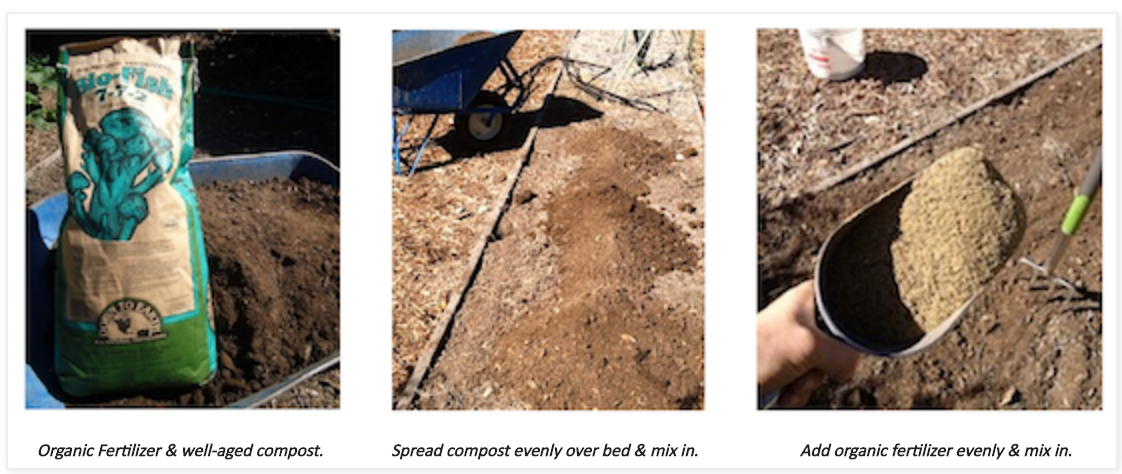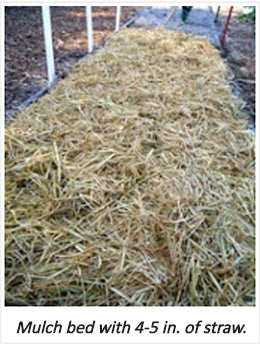
Growing Great Garlic #1: Planting
by Renee Shepherd and Lindsay Del Carlo
Garlic is both easy to grow and takes up so little space that just about every gardener, even those with very limited space, can raise enough to be happily self-sufficient in this important and healthy cooking essential.
This article is about how to plant garlic in your garden. Also see our article on Harvesting Garlic.
Renee's Garden Garlic Varieties

The fall weather of early to mid October (the same time as you would plant daffodil or tulip bulbs to over-winter) is a good time to plant garlic in most of the country. (In very mild climates, it can be planted clear through November.) You want to get the garlic plants actively growing before the days get too short and weather turns cold, so plants will over-winter successfully and produce big fat bulbs in early summer.
The first step is to prep the beds. We chose a garden bed in full sun and amended with lots of well-aged compost, and worked in a high nitrogen, granular organic fertilizer. We are using Down To Earth brand “Bio-Fish” fertilizer which has a high nitrogen content to grow hefty garlic bulbs, but there are lots of good organic brands of fertilizer choices nowadays available at garden centers; availability varies from region to region. Dr. Earth and MaxSea are two other good brands.

Garlic bulbs need to be separated into individual cloves for planting. Each clove is planted 6 inches apart and 1 1/2 inches deep with its tip pointing up and the root end down. Garlic planted in fall will establish vigorous roots before the weather turns cold and days get very short, then plants will grow vigorously throughout spring while each clove grows into a full head underground.

 After planting the cloves, we are careful to add a thick straw mulch to the planting bed. Garlic tops will sprout up easily through the open texture of the straw.
After planting the cloves, we are careful to add a thick straw mulch to the planting bed. Garlic tops will sprout up easily through the open texture of the straw.Mulching the garlic bed keeps soil moisture consistent while fall weather is still warm after planting, and performs the critical task of protecting the garlic bed from erosion and nutrient leaching during the winter weather.
In cold winter climates, where the ground freezes hard, the heavy mulch will also protect plants from frost heaving.
Read Harvesting Garlic
Renee's Garden Garlic Varieties

The fall weather of early to mid October (the same time as you would plant daffodil or tulip bulbs to over-winter) is a good time to plant garlic in most of the country. (In very mild climates, it can be planted clear through November.) You want to get the garlic plants actively growing before the days get too short and weather turns cold, so plants will over-winter successfully and produce big fat bulbs in early summer.
The first step is to prep the beds. We chose a garden bed in full sun and amended with lots of well-aged compost, and worked in a high nitrogen, granular organic fertilizer. We are using Down To Earth brand “Bio-Fish” fertilizer which has a high nitrogen content to grow hefty garlic bulbs, but there are lots of good organic brands of fertilizer choices nowadays available at garden centers; availability varies from region to region. Dr. Earth and MaxSea are two other good brands.

Garlic bulbs need to be separated into individual cloves for planting. Each clove is planted 6 inches apart and 1 1/2 inches deep with its tip pointing up and the root end down. Garlic planted in fall will establish vigorous roots before the weather turns cold and days get very short, then plants will grow vigorously throughout spring while each clove grows into a full head underground.

 After planting the cloves, we are careful to add a thick straw mulch to the planting bed. Garlic tops will sprout up easily through the open texture of the straw.
After planting the cloves, we are careful to add a thick straw mulch to the planting bed. Garlic tops will sprout up easily through the open texture of the straw.Mulching the garlic bed keeps soil moisture consistent while fall weather is still warm after planting, and performs the critical task of protecting the garlic bed from erosion and nutrient leaching during the winter weather.
In cold winter climates, where the ground freezes hard, the heavy mulch will also protect plants from frost heaving.
Read Harvesting Garlic



